by Ron Ploof | Mar 15, 2020 | Business Storytelling
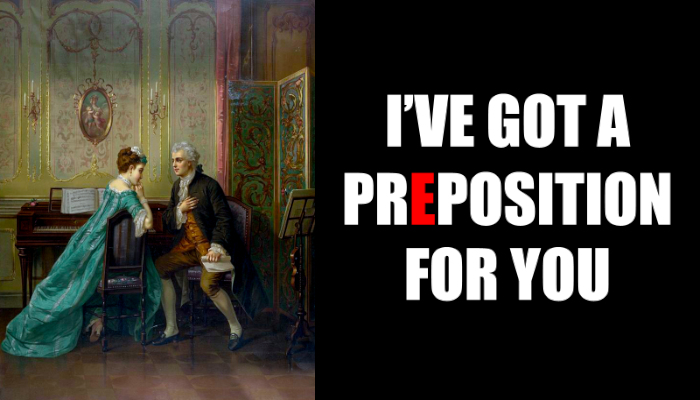
It’s called the Big Idea–the foundation of any best-selling book, blockbuster movie, or TED Talk. They’re frequently found in rare Ah-ha! moments, when clarity emerges unexpectedly from sustained periods of doubt and frustration. And while the euphoric rush from such flashes is intoxicating, the emotional high is short-lived once the discoverer contemplates the daunting task of explaining it to someone else.
Experienced authors, storytellers, and keynote speakers know that sharing big ideas is harder than discovering them. Why? Because big ideas are built upon personal life experiences, while the messages crafted to represent them must be filtered through a listener’s unique life experiences.
So, how do we convert complex concepts–some which may have taken us years to develop–into works that resonate with large numbers of people? The secret is found in the everyday words we use to describe the human condition: prepositions.
While it’s trendy in today’s world to highlight our differences, we find a universal core under all those layers: all 7.64 billion of us of were born and have evolved into the beings we are today. Although that statement may sound simple, consider that each one of us has impossibly derived the SAME big idea from our billions of experiences. “We are physical beings, bounded and set off from the rest of the world by the surface of our skins, and experience the rest of the world as outside us. Each of us is a container, with a bounding surface and an in-out orientation onto other physical objects that are bounded by their surfaces. Thus, we also view them as containers with an inside and an outside.”1
This notion of inside and outside–or the state of actually being inside or outside–is an extraordinary complex idea. Having shorthand like in and out to describe our physical locations is a life imperative, which is probably why they’re the seventh and forty-third most common words used in the English language.2 We–and I mean all 7.64 billion of us–then bootstrap our understandings of new concepts from our deep connection to these two words.
For example, let’s take a look at the seemingly incongruous concept of being inside and outside simultaneously. We can be inside a warm coat, while outside of our home. This knowledge leads to another concept: transition–the fact that we can move back into our houses and out of our coats…and vice versa.
Everyday experiences teach us something new. We’ve learned that our environment affects us. The “simple” act of walking involves an constant struggle between our wills to remain upright and an invisible force that pulls us downward. Although children don’t fully understand the force of gravity–actually, the world’s best physicists still don’t–we accept it as an inescapable part of the human condition. As a result, when we fall down, we’re expected to get back up.
And so we add up and down to our list of tiny words used to describe life experiences. But up and down carry other connotations. Since the act of falling down is unpleasant and getting up is better, we associate up as good and down as bad. Thus, when we’re asked to describe another complex concept such as mood, we answer with seemingly nonsensical things like, “I’m feeling up today,” or “I’ve been down for a while.” Yet, no matter how illogical it may seem to describe emotional states using orientational words, we get it because we’ve all lived it.
The more experiences we have, the more concepts we need to express. For example, consider the impossibly complex concept of love. We can be in or out of it. Actually, we can fall into or out of it, suggesting that love is some sort of container with an inside and an outside. But that’s not exactly right because we can be in love and still hold love in our hearts…again…simultaneously! And just when we’re comfortable with love being a container, Pat Benatar tells us that love is a surface because Love is a Battlefield.
Love is such a vital yet complex concept, prior generations have written plays, books, songs, and proverbs to describe it.
In addition to being a container and a surface, love appears to be a force because Love makes the world go ’round, Love conquers all, and Love makes the impossible possible. This mysterious container/place/force also seems to have cognitive abilities because Love understands all languages. And while love is a force that can understand, it also has the ability to cloud our judgement as Love makes a good eye squint.
1 Corinthians 13: 4-7 describes love as a best friend who’s patient, kind, humble, respectful, forgiving, truthful, trusting, hopeful and persistent. With all of these definitions as a container/surface/force with friend-like cognitive abilities, it’s a wonder that we have any understanding of what love is at all.
But we do, because the longer we experience the human condition, the more opportunities we have to experience love’s infinite facets.
So, you wanna share a big idea? Start with the words used to describe our relationship to the human condition: prepositions. Prepositions will eventually lead to metaphors–the building blocks of all human understanding.
Do so by asking yourself a few questions about your big idea:
- How might I represent my big idea as an object, substance, container, surface, event, action, activity, or state?
- Does it have an inside, outside, top, or bottom that allows us to be in, out, on, off, over, or under it?
- Does it come with some things and/or without others?
- Is it stationary or does it move? If it moves, does it move toward or away?
- Are there any advantages or disadvantages to being by, at, or near it?
- How is it viewed? Do we look up, down, or sideways at it?
- Is it part of a process, where something happens before or after it?
- Is it the cause of something or the result of something else?
- Did it emerge from something or does something emerge from it?
- Is it adversarial? Perhaps it’s for something and against something else?
When trying to convey a big idea, forget the big words and apply a laser-like focus on the small ones that we as humans rely upon daily. Prepositions lead to metaphors and metaphors lead to universal meaning.
Notes:
1. George Lakoff and Mark Johnson, Metaphor We Live By (University of Chicago Press, 2003) Kindle e-book location 521/4362
2. https://en.wikipedia.org/wiki/Most_common_words_in_English
Photo Credit: A. & C. Kaufmann, and Otto Erdmann. Proposal / original by Otto Erdmann ; chromo-lithographed and published by A. & C. Kaufmann, 366 Broadway, New York. , ca. 1873. New York: Published by A. & C. Kaufmann, 366 Broadway. Photograph. https://www.loc.gov/item/99400105/
by Ron Ploof | Mar 1, 2020 | Business Storytelling
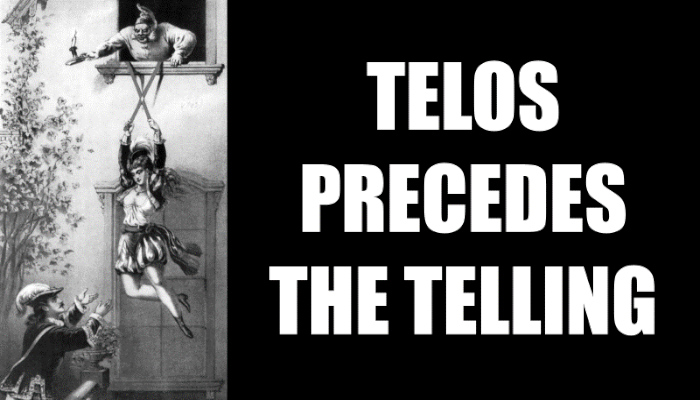
Studying words from other languages is useful because they often capture a meaning that may not translate directly into one’s native tongue. Today’s example comes from the Greek word telos, which loosely translates to goal or end, but more accurately embodies the concept of the ultimate goal or the ultimate end.
According to Aristotle, telos resides in everything animal, vegetable, or mineral, and somehow, each one works in concert. While a rabbit’s telos may be to survive, it can only do so through a complementary collection of internal telos, like remaining safe, finding food, and reproducing. And although the telos of vegetables and minerals may not involve bunny-consciousness, they each play a role in feeding the rabbit’s hunger and forming a cave for the rabbit’s family to live in.
Let’s take a look at the role of telos in communicating. You’ve been tasked with presenting the results of your most recent project. So, what’s your telos? By the time you thank your audience for their time, what do you want them to walk away with? Is it to look at an issue from another perspective, change the way they’re doing things, or encourage them to double down on a controversial action because it’s the right thing to do?
Unfortunately, most people skip the telos step, preferring to jump right into the recitation of fact after tactical fact. Sadly, the telos of most presentations is to “get it out of the way” instead of conveying a subject’s deeper meaning.
For example, I recently found myself in the audience of a dreadful business presentation. When the presenter noticed that he’d completed his talk fifteen minutes ahead of his one-hour time slot, he said, “Wow! I thought I had too many slides!” Obviously his telos wasn’t to communicate, but to create enough slides to fill the time allotted.
To be fair, telos-driven talks require work that most people don’t think that they have the time to invest. But in reality, every presentation is a pay-telos-now-or-pay-telos-later situation. The less telos pre-work presenters put into their presentations, the more audiences must asses their own telos by asking internal questions such as:
- How does this information apply to me?
- Why am I sitting here?
- When is catering restocking that refreshments table?
Storytelling telos plays a fundamental role in my various interactions with people:
- The telos of my lectures is to teach a certain message.
- The telos of my opening stories is to bond with my audience.
- The telos of a story told over a pint of beer is usually to entertain.
- The telos of a Griddlecakes Radio story is to convey a life-lesson that a specific experience taught me.
Before you present, ask yourself, What’s my telos? Is it to add moisture to a dry subject, such as was my telos for writing The Proverb Effect? Is it to add personality to data, change a perspective, or to bond over a common experience?
Whichever way you choose, telos-driven communications strategies also contain a built-in quality control mechanism. When used, you’ll always be able to look back on a presentation and determine whether you were successful or not.
Image Credit: Metallic End Suspenders. , ca. 1874. Photograph. https://www.loc.gov/item/2001701469/.
by Ron Ploof | Feb 17, 2020 | Business Storytelling
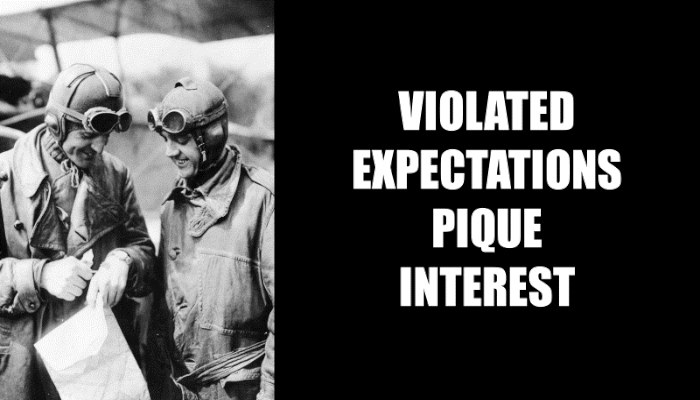
Recently, I’ve noticed an increase in the number of people expressing versions of the same phrase:
“That’s an interesting question, Ron.”
At first I didn’t think much about it. But as I heard the question more frequently, I started wondering, “Why do they find my questions interesting?”
I kept coming back to the same answer: Storytellers are masters of making things interesting. Consider that a storyteller can keep you staring at a flickering screen for two hours in a darkened room filled with strangers. Story has the power to keep a group of squirrelly children fixated on a teacher reading a book to them. And story is the reason you’ll spend days or weeks digesting a three hundred page novel.
You see, storytellers know how to actuate the neurons responsible for a piquing a listener’s interest. And once you know this secret, you can too. So, do you want to know how to do the same?
It’s simple. Violate people’s expectations. Show them something that they didn’t expect. Zig when they expect you to zag. Whisper when they expect you to scream at the top of your lungs. Stand when they expect you to duck.
All stories start when someone’s expectations are violated and it can be tracked back to Kenn Adam’s trusty Story Spine:
Once upon a time,
Everyday,
Then one day,
And because of that,
And because of that,
Until finally,
And ever since that day.
Then one day separates ho-hum from interesting. Let’s try it out.
Once upon a time, Jane would drive to work
Everyday, she’d arrive on time
Then one day, she…
- Got a flat tire
- Decided to take a detour
- Got delayed by a rogue herd of goats
All stories start by violating someone’s expectations. And there’s a corollary to this rule: Anger piques when our metaphors are violated.
If you find yourself getting heated, it’s likely because someone violated a fundamental belief that you live by. Maybe you expected someone to act a certain way and yet they didn’t. Perhaps someone cut in line, spoke to you condescendingly, or acted recklessly, thus placing you or others in unnecessary danger. If someone violates a metaphor that guides your personal definition of right and wrong, your natural instinct will be to react swiftly and emotionally.
So, why are people finding my questions interesting? I guess because I’m injecting my experience as a storyteller into the conversation. I’m constantly trying to understand the motivations of the players involved. If a long-time satisfied customer suddenly changes behavior by making odd emotional requests, rather than reacting defensively, I’ll ask my colleagues questions like:
- What are they trying to accomplish with this request?
- What is the real source of their frustration?
- What core beliefs might we have violated accidentally?
I’m finding that this line of questioning helps my coworkers not only address the problem from a new perspective, but they also start asking their own interesting questions.
Photo Credit: Photograph of Army Air Corps pilots Maj. Reuben Fleet and Lt. George Boyle on May 15, 1918 ; National Postal Museum, Benjamin Lipsner Collection. Photographer: Unknown.
by Ron Ploof | Feb 2, 2020 | Storytelling
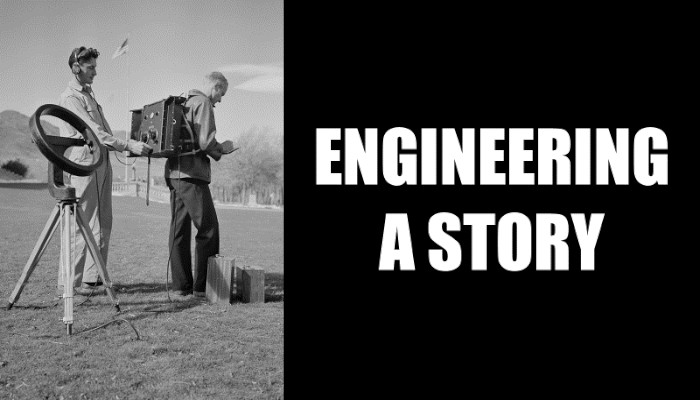
“You know, Ron,” one of my friends said recently, “You breakdown story like an engineer.”
While I’d never really thought about it that way before, she’s right. Story is a massively complicated subject that I’ve approached by using the skills that I learned in engineering school.

I was a sophomore engineering student at Merrimack College when the professor stopped in the middle of his Digital Signal Processing lecture and dropped a non sequitur. “Why are you here?”
The students just stared at him.
“Why do you want to be an engineer?” Dr. Develis pressed. “Why did you choose a major with such rigor?”
We still had nuthin‘.
He smiled and decided then let us off the hook. “You’re here to learn just one thing.”
We laughed. Surely, he couldn’t be serious. We had to learn mathematics, physics, circuit theory, and control systems. We’d be taking classes in linear algebra, calculus, differential equations, and electromagnetics–not to mention the religion and philosophy courses required to graduate from an Augustinian school.
He dismissed our protests. “Your four years in Engineering school will teach you one thing: a method to solve problems. You’ll learn how to break big problems into small ones. Then, by solving the small problems, you’ll eventually solve the big ones.”
As we pondered that thought, he then made a disturbing prediction. “And you’ll get so good at it, that some people will hate you for it.”

Although I didn’t believe him at the time, life has proved his grim prophecy to be true. It tends to happen while working on big problems with someone who wants to solve them whole. Unfortunately, all-at-once strategies frequently become a jumbled mess of subjectivity, passion, and emotion–all great things when bringing energy to a problem–but terrible while trying to solve one.
My training forces me to look at problems objectively. First I seek to uncover the root causes to problems. Next I learn as much about them as I can. Finally, I break the big problem into smaller, more manageable ones. The process is ruthlessly sequential and simultaneously infuriating to someone who values action over achievement.
Problem-solving is in my DNA. My work is covered with its fingerprints. For example, The StoryHow™ PitchDeck breaks storytelling into four parts: roles, events, influences, and techniques. The Proverb Effect breaks proverbs down into their base components of function, frame, and finish.
Love me or hate me, I am what I am–a storyteller with a degree in Electrical Engineering.
Photo Credit: United States Office Of War Information, Feininger, Andreas, photographer. Science and research. Mineral prospecting. A ground comparator will reveal the presence of an ore body under the surface of the earth by measuring the total intensity and the plane of polarization of the secondary electro-magnetic field set up by the ore body. These students are using an adjustable coil of copper wire which acts as an electrical transformer, and may be tilted to determine the minimum and maximum intensity of the field. They are conducting an experiment in electronics, taught in the department of geophysics at a famous mining engineering school. They will apply the knowledge they are acquiring to airplane detection and anti-submarine warfare. Colorado School of Mines, Golden, Colorado. Colorado Golden Golden. Jefferson County United States, 1942. Oct. Photograph. https://www.loc.gov/item/2017696228/.
by Ron Ploof | Jan 18, 2020 | Business Storytelling
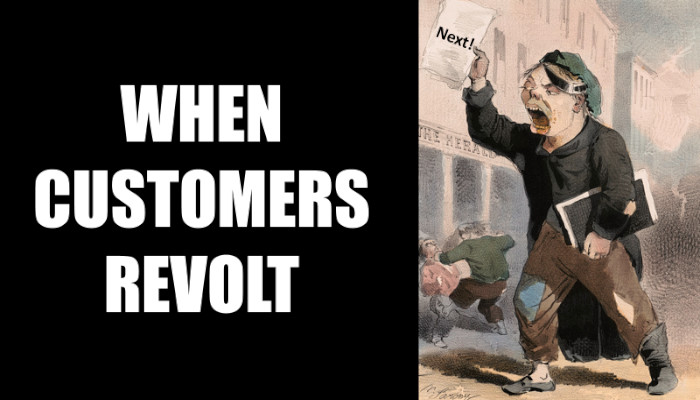
The presentation began as most do. The presenter began flipping through a series of PowerPoint slides that he’d pulled from the company’s internal marketing database. They contained all the traditional basics, including the dreaded We Are the World opening–ya know–the one that makes your company sound like a Clint Eastwood character in a spaghetti western?
Most of the time, customers sit dutifully through these sycophantic preambles…well, except for this day…when one of the customers decided to add color commentary.
“Yeah, we know that you’re the best. You wouldn’t be here otherwise.”
The presenter smiled and advanced to the next slide that talked about the company’s quality.
“Quality? Well, I sure hope so,” the customer said sarcastically.
The presenter advanced to the next slide that contained platitudes of industry dominance.
“Look, we know that you’re awesome and everyone loves you. Can we move on?” The now-emboldened customer proceeded to bark the word, “NEXT!” with each subsequent self-aggrandizing slide.
I find it astonishing that more than ten years into the Content Marketing movement, marketers haven’t relocated their We are the World sections to the appendices of their presentations. Is the information important? Sure. Purchasing from the industry leader is an important piece of information for a buyer–but only AFTER customers conclude that the product meets their requirements. Putting the bravado-cart before the functional-horse is not only unproductive, it’s disrespectful to audiences who are obviously no longer willing to sit passively.
Take a look at your most recent marketing presentations. Do they contain We are the World sections? If so, would it really hurt to move them to the appendix as backup sides?
Photo Credit: Sarony & Major, Lithographer. One of the news-b’hoys / Lith. of Sarony & Major. New York, 1847. New York: Published by T.W. Strong. Photograph. https://www.loc.gov/item/2003664125/.




